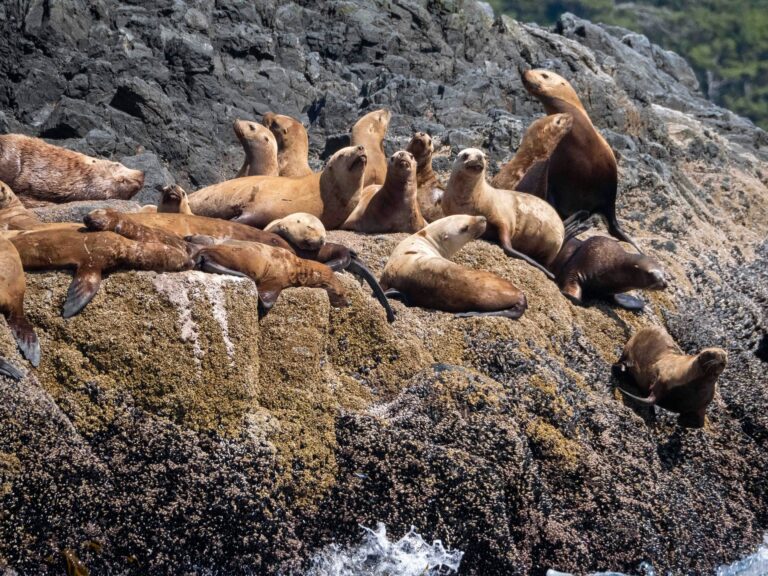In the vast expanse of the ocean, amidst crashing waves and swirling currents, there exists a creature that captures the hearts of many with its charm and grace – the sea lion. These magnificent marine mammals, often referred to as the acrobats of the ocean, possess a unique set of traits and behaviors that make them truly endearing. From their playful antics to their remarkable agility, sea lions captivate both scientists and nature enthusiasts alike. In this article, we delve into the fascinating world of sea lions, exploring their physical characteristics, social behaviors, feeding habits, reproductive strategies, conservation status, and much more. Join us as we uncover the secrets of these captivating creatures and celebrate the enchanting personality of sea lions.
Size and Weight
Sea Lion Size:
Sea lions exhibit significant size variations depending on the species. Generally, male sea lions are larger and heavier than females. For instance, California sea lions (Zalophus californianus) typically measure around 2.4 meters (8 feet) in length and weigh between 200 to 400 kilograms (440 to 880 pounds). Conversely, female California sea lions usually measure about 1.8 meters (6 feet) in length and weigh between 50 to 110 kilograms (110 to 240 pounds).
Diversity in Species:
There are various species of sea lions, each with its own unique size and weight characteristics. For example, Steller sea lions (Eumetopias jubatus), the largest of all sea lion species, can grow up to 3.3 meters (10.8 feet) in length and weigh as much as 1,000 kilograms (2,200 pounds) for males, while females are notably smaller, typically reaching lengths of around 2.3 meters (7.5 feet) and weighing up to 350 kilograms (770 pounds).
Factors Influencing Size:
Several factors contribute to the size and weight variations among sea lions. These factors include genetics, geographical location, availability of prey, and environmental conditions. Generally, sea lions inhabiting regions with abundant food resources tend to grow larger compared to those living in areas with limited food availability.
Adaptations for Aquatic Life
Streamlined Body Shape:
Sea lions have evolved streamlined bodies with tapered ends, facilitating efficient movement through water. Their streamlined shape reduces drag, allowing them to swim swiftly and with minimal effort. This adaptation is crucial for capturing prey and evading predators in their aquatic environment.
Flippers and Limb Adaptations:
Sea lions possess powerful forelimbs, or flippers, which they use to propel themselves through the water. These flippers are long, flexible, and muscular, providing excellent maneuverability. Additionally, their hind limbs are modified into short, sturdy flippers, aiding in steering and stabilization while swimming.
Buoyancy Control:
Sea lions have specialized adaptations to regulate their buoyancy underwater. They possess a thick layer of blubber beneath their skin, which not only provides insulation but also aids in buoyancy control. By adjusting the amount of air in their lungs and manipulating their body position, sea lions can control their depth and remain submerged for extended periods during dives.
Remarkable Agility and Flexibility
Agile Swimmers:
Sea lions are incredibly agile swimmers, capable of performing intricate maneuvers with precision. Their streamlined bodies, coupled with powerful flippers, enable them to navigate through water with remarkable speed and agility. This agility is advantageous for hunting fast-moving prey and evading potential threats.
Flexible Joints:
Sea lions exhibit exceptional flexibility due to their unique skeletal structure and joint mobility. This flexibility allows them to twist, turn, and contort their bodies effortlessly, both in water and on land. Such flexibility is essential for executing complex swimming techniques and adapting to various environmental conditions.
Acrobatic Abilities:
Sea lions are renowned for their acrobatic prowess, often showcasing impressive aerial displays in their natural habitat. They can leap out of the water, perform graceful flips, and even balance on their flippers while swimming. These acrobatic abilities not only serve as a means of communication and courtship but also play a role in thermoregulation and predator avoidance strategies.
Social Behavior and Communication
Group Dynamics:
Sea lions are highly social animals, often forming large colonies or groups known as rookeries. These rookeries can consist of hundreds to thousands of individuals, depending on the species and environmental conditions. Within these groups, sea lions exhibit complex social hierarchies, with dominant individuals often asserting control over resources such as breeding territories and access to food. Group living provides benefits such as increased protection from predators, cooperative hunting opportunities, and communal care for young offspring.
Vocalizations and Communication Signals:
Sea lions communicate through a variety of vocalizations and visual signals, which play crucial roles in maintaining social cohesion and coordinating group activities. Vocalizations can range from deep, resonant barks to high-pitched calls, each serving different purposes such as establishing territory, signaling aggression, or coordinating group movements. Additionally, sea lions use body postures, gestures, and facial expressions to convey information and intentions to other members of their group. These communication signals help reinforce social bonds, resolve conflicts, and facilitate cooperation among individuals.
Playful Interactions and Bonding Rituals:
Play behavior is prevalent among sea lions and serves multiple functions within their social structure. Young sea lions, in particular, engage in playful interactions as a means of developing essential social and motor skills, practicing hunting techniques, and establishing bonds with peers. Play can involve activities such as chasing each other, wrestling, or engaging in mock fights. Additionally, adult sea lions may also participate in playful behaviors, which serve to strengthen social bonds, relieve stress, and maintain group cohesion. Alongside play, sea lions also engage in various bonding rituals, including grooming, tactile interactions, and vocal exchanges, which help reinforce social connections and foster a sense of community within the group.




